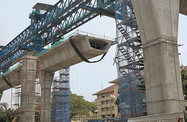Government officials have pledged that road improvements currently underway in Sabah will form part of a sweeping development plan that is expected to benefit every district in the state. The plan includes expansion projects and new roads that will improve connectivity through the region, which will provide the state’s districts with a number of economic opportunities. However, it faces scepticism from some districts where people fear the upgrades will not stretch deep enough into rural areas.
As part of a state-wide development plan to be rolled out in phases, a 30-km road stretching from Lok Kawi township to the town of Papar will be widened, Najib Razak, Malaysia’s prime minister, said in mid-February.
Although the road-widening project has yet to be officially confirmed, Abdul Rahim Ismail, the state assemblyman of Pantai Manis, Papar, told local media the estimated cost of the project should be around RM300m ($96.64m). Papar is considered a key link for Kota Kinabalu, the capital of Sabah, as well as Brunei Darussalam and Sarawak.
In late 2012 Najib also pledged to build an RM800m ($257.72m) coastal road linking Tuaran, Kota Marudu and Kudat, a development that was welcomed by local officials. According to Maximus Ongkili, the member of parliament for Kota Marudu, the proposed road will bring economic transformation and development to northern Sabah.
Earlier, in July 2012, the national government also revealed that a planned upgrade of the 2330-km Pan Borneo Highway will see Sabah and Sarawak connected with a four-lane dual carriageway. The highway is expected to cost some RM16bn ($5.15bn). Additional projects could be announced in the run-up to the Malaysian general election, expected to be held in June.
The ambitious plans to improve state-wide road links fit well with a strategy from the Sabah Economic Development and Investment Authority (SEDIA) to upgrade public transportation in the state capital. SEDIA has put public transport plans at the centre of a strategy to modernise Kota Kinabalu. The authority plans to improve the condition of buses, increase their frequency and service, and even launch a study on a light-railway transit system in hopes that public transport will reach a target of 21-25% modal share by 2020.
Kota Kinabalu is also expected to benefit from its inclusion in a government plan to create an Urban Transformation Centre (UTC) in the capital, similar to others being built around the country. UTCs are expected to provide a cluster of government and private sector services associated with health, banking and finance, education and training, utilities, security, welfare, entrepreneur development and retail space.
However, officials in more far-flung areas of the state complain they are not seeing the benefit of state- and nation-wide initiatives. It was estimated in mid-2011 by the State Public Works Department (PWD) that some 65% of roads in Sabah are not tarred. Bung Mokhtar Radin, the member of parliament for the Kinabatangan district, in November 2012 urged the Ministry of Rural and Regional Development to build roads in his rural constituency. “It is very difficult for the villagers, particularly in this monsoon season, and communications among villages can be cut off,” he said.
According to John Anthony, the director of the PWD, Sabah will require RM10bn ($3.22bn) to tar its 12,000 gravel roads to attain the national average of 80% sealed roads. To this end, the national government has allocated RM4.5bn ($1.45bn) to reduce the urban-rural development gap and construct 441 km of rural roads nationwide.
Meanwhile, in October 2012 Sabah’s Chief Minister, Musa Aman, revealed that RM763.7m ($249.3m) would be spent on infrastructure in 2013, with RM742.95m ($242.5m) set aside for upgrading roads and bridges, RM7.25m ($2.4m) for the railway, and RM13.5m ($4.4m) for ports and harbours.
As progress on the nation’s roadways develops, sea transport remains a vital aspect of the state’s trade sector, with the Federation of Sabah Manufacturers (FSM) in January calling for Malaysia’s sea transport centre to be relocated from Bintulu, Sarawak to Sabah. Not only would locals benefit from Sabah becoming a sea transport centre, but so would the wider region, including countries such as China, Indonesia and Korea, as the state is situated in the middle of the Brunei Darussalam-Indonesia-Malaysia-Philippines East ASEAN Growth Area, said Wong Khen Thau, FSM president.
While there are several projects currently underway that will indeed strengthen connectivity and spur economic growth, to truly improve the provision of transport services throughout the state, leaders must ensure that upgrades reach every corner of the state, in addition to focusing on big-ticket infrastructure projects.

